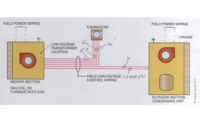Bob is a service technician who is well trained and nationally certified. However, he sometimes suffers from the same confusion that all technicians occasionally do — the facts that he gathers may or may not point to the obvious cause of the problem or the best solution. But Bob has had something that no one else has. He recalled his long-time HVACR mentor and imagined him accompanying him as “Btu Buddy,” someone who reminded him to take time to stop and think before rushing to judgment, helped keep him on the right track, even with facts that are confusing.
Now, Bob’s company has promoted him to helping train a new employee, right out of a school specializing in HVAC, just like Bob was. Bob is now Tim’s BTU Buddy. Tim is anxious to travel with Bob. Tim realizes that he is right out of school, with the theory and lab work that he accomplished in school, but still needs help. He knows that he worked with many of the components of the systems in the school, under ideal conditions with good light and air conditioning. Now it is into the field, sometimes under the house with poor lighting, or out on the rooftop in the sun, where the real action is. He is naturally and normally reluctant, but he has Bob to help guide Him.
Bob and Tim were on their way to a no heating call. When they arrived, they looked at the house and saw that it had a package unit. The house was about 20 years old and the package unit looked to be the same age. They talked to the housewife and she told them that the unit stopped running sometime in the middle of the night last night. It was cold in the house and she had a new baby. Bob and Tim went to the thermostat and turned the ‘fan on’ switch to on and noticed that the fan did not start. They then went to the outdoor unit with the thermostat turned up for heating to see what was going on out there. It is a gas-fired package unit
Bob said, “The indoor fan did not start when we turned the fan switch to on. That leads me to believe that there may be a low-voltage power problem. Let’s check the low-voltage power supply.”
Tim removed the panel to the control compartment and checked the voltage at the transformer outlet and there was no low voltage. He said, “That was a good call. We have no power on the low-voltage side.”
Bob said, “It was pretty obvious to me unless we had a fan relay problem. Check the voltage to the transformer primary side.”
Tim checked the low voltage to the primary side of the transformer and said, “There’s 240 V to the primary of the transformer.”
Bob said, “I would say that the transformer is bad. Turn off the power and cut the wires to the primary and secondary and let’s check it with an ohmmeter.”
After the ohmmeter test, Tim said, “The primary side of the transformer is open circuit, the secondary side is good (Figure 1).”
Bob took the transformer and peeled the paper back from the coils and said, “This coil is burned up. Look at the burned copper coils. Go to the truck and get a new transformer and let’s install it (Figure 2).”
They installed a new transformer and turned the power on and nothing happened. Tim was scratching his head and wondering what was going on.
Bob said, “I can’t imagine what could be wrong. That’s a new transformer. Check the primary voltage and see what it reads, and then check the secondary voltage.”
Tim checked both voltages and said, “There are 240 V on the primary side and zero volts on the secondary side, just like it read a while ago. What should I do next?”
Bob then said, “Turn off the power and let’s run an Ohm check on the field circuit to make sure that there is a power consuming device in that circuit. There is a possibility that there may be a short circuit in the field circuit which would overload the transformer and may burn it up again.”
Tim did an Ohm check on the secondary circuit, which would run through the gas relay and the fan relay, and said, “There seems to be about 26 Ohms resistance in the control circuit. That is a 40 VA transformer and should be able to carry 1.67 amperes. (40 VA/24 volts = 1.67 amperes).”
Bob said, “If we use Ohm’s law, I = E/R, we would have about .9 A in that circuit (I = 24/26 = .9). That is not enough amperage to burn the transformer this quickly. Ohm out the transformer again both primary and secondary.”
Tim then said, “The transformer’s primary is open circuit, just like the other transformer. The secondary circuit has continuity through it. This means that the primary circuit must be burned up again.”
Bob then said, “I do not believe that the primary circuit is burned. I believe we may have a defective transformer. Take the transformer out and let’s peel the paper back and see what we see in the coils underneath the paper.”
They removed the transformer and gently peeled the paper back away from the coils and the coils looked brand new but they had no circuit through them.
Bob then said, “I’m going to say that we did not burn the transformer. This transformer must have arrived with an open circuit. Just to be sure let’s install a transformer that has a fuse in both the primary and secondary circuit. Then we may blow a fuse but not burn a transformer.”
Tim then asked, “What should we do next?”
Bob said, “I think we should put a new 40 VA transformer in this system and install a fuse in the primary and secondary circuit. I think we should put a one half amp fuse in the primary circuit and a 2 amp fuse in the secondary circuit, just to be safe. This will protect us in case either one of the operating coils goes to excessive amperage when energized. I can’t believe that would happen; we can be sure with fuses. Go to the truck and get two fuse holders, the kind that wire in-line with the wire (Figure 3), and we will need to go to the supply house and get the fuses. I don’t believe we have those size fuses on our truck. We will have to look and see.”
They had to go to a supply house and get the fuses for the system. When they had everything together, they installed the fuse holders in the lines, one in the transformer’s primary circuit and one in the secondary circuit.
They closed the disconnect switch and the heating system started right up. This confirmed that the second transformer was defective when they got it.
Bob then said, “We would have been far ahead if we had checked that second transformer before we installed it. You wouldn’t think that you should have to do that, but it’s never a bad idea to check your new parts out before installing them.”
Tim said, “We seem to learn something different every day.”
Bob said, “Yes, these kinds of things keep life interesting.”
Publication date: 11/21/2016
Want more HVAC industry news and information? Join The NEWS on Facebook, Twitter, and LinkedIn today!













